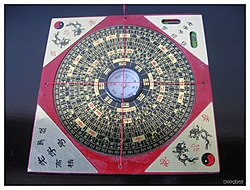
In ancient times as well as today, Feng shui, pronounced in English as [fʊŋ'ʃweɪ] ("fung shway"), was known as "Kan-Yu" which means 'The Law of Heaven and Earth.'
Feng shui is a discipline with guidelines that are compatible with many techniques of architectural planning. Space, weather, astronomy, and geomagnetism are basic components of feng shui. However, many believe there are inexplicable factors involved and so consider it a metaphysical art. Proponents claim that feng shui has an effect on health, wealth, and personal relationships.
Instrumentation
The goal of feng shui as practiced today is to situate the human built environment on spots with good qi. The "perfect spot" is a location and an axis in time. Some areas are not suitable for human settlement and should be left in their natural state.
Some current techniques can be traced to Neolithic China, while others were added in later times (most notably the Han dynasty, the Tang, and the Ming). Today, to determine a perfect spot, local manifestations of qi must be assessed for quality. Quality is determined by observations and by using a compass (Luopan).
Foundation theories
Qi is a difficult word to translate and is usually left untranslated. Literally the word means "air". In feng shui, "Qi" means "flow of energy". Max Knoll suggested in a 1951 lecture that qi is a form of solar radiation.
Qi (ch'i)
Polarity is expressed in feng shui as Yin and Yang. The polarity within feng shui is buildings of the living (yang) and buildings of the dead (yin).
Polarity
Two diagrams known as bagua (or pa kua) loom large in feng shui, and both predate their mentions in the Yijing or I Ching. The Lo (River) Chart (Luoshu, or Later Heaven Sequence) and the River Chart (Hetu, or Early Heaven Sequence) are linked to astronomical events of the sixth millennium BCE, and with the Turtle Calendar from the time of Yao.
Bagua (eight symbols)
An often-misunderstood term in Feng Shui is that of schools. A school (at least in Feng Shui) is a technique. The concept is well known to Chinese -- for example, the "Thousand Schools of Thought" mentioned by Mao Zedong. But Westerners often confuse the term with a physical school, when something less tangible may be meant. There are many 'masters' of the different Feng shui schools. However, some maintain that authentic masters impart their genuine knowledge of Feng shui only to selected students.
Bagua (relationship of the five phases or wuxing)
Five phases (wuxing relationships)
Xuan Kong (time and space methods)
Xuan Kong Fei Xing (Flying Stars methods of time and directions)
Xuan Kong Da Gua ("Secret Decree" or 64 gua relationships)
Xuan Kong Shui Fa (time and space water methods)
Zi Bai (Purple-White Flying Stars methods)
Ba Zhai(Eight Mansions)
San Yuan Dragon Gate Eight Formation
Major & Minor Wandering Stars
San He Luan Dou (24 Mountains, Mountain-Water relationships)
San He Shui Fa (water methods)
Qimen Dunjia (Eight Doors and Nine Stars methods)
Zi wei dou shu (Purple King, 24-star astrology) Fundamental techniques
One of the grievances mentioned when the anti-Western Boxer Rebellion broke out was that Westerners were violating the basic principles of Feng shui in their construction of railroads and other conspicuous public structures throughout China. At the time, the Westerners concerned had indeed little idea of or interest in such Chinese traditions.
Since Richard Nixon journeyed to China, Feng Shui has been rediscovered by Westerners. It has been reinvented by New Age entrepreneurs for Western consumption. Feng shui speaks to the profound role of magic, mystery, and order in American life. BTB Feng Shui has a unique and specially created bagua, with each of the eight compass segment directions representing a particular area of one's life.
Shen Dao Feng Shui - Developed in the late '70's by Harrison G.Kyng.
Shen Dao style became the first school of its type in the UK. Based upon both 'Form' and 'Compass' styles, Shen Dao utilises the Five Element modality to assess its clients health as well as their buildings harmony. This relationship is said to create a unique 'viewpoint' that can then be used to create a greater sense of harmony both inwardly and outwards. Shen Dao's unique compass uses the former heavenly sequence and expands the Ba Gua into over 300 harmonics that help to fine tune its results.
New Version
Victorian-era commentators on feng shui were generally ethnocentric, and as such skeptical and derogatory of what little they knew of feng shui.
Penn & Teller did an episode of their television show Bullshit! that featured several Feng Shui practitioners in the US, and was highly critical of the inconsistent (and frequently odd) advice. In the show, the entertainers argue that if Feng Shui is a science (as some claim), it should feature a consistent methodology.
People have reacted skeptically towards the alleged benefits of crystals, wind chimes, table fountains, and mirrored balls, etc., on one's life, finances, and relationships. Often, these claims are dismissed as New Age, pseudoscience, relying on the placebo effect, or even outright fraud.
Criticism
A growing body of research exists on what is now called "traditional" or "classical" feng shui.
Landscape ecologists find traditional feng shui an interesting study. that is feng shui.
 Current research
Current researchArchitects in Sydney and Hong Kong were surveyed by researchers regarding their selection of the environment for a building and interior layout. The architects generally concurred with the ideal feng shui model.
It has also recently been included in the Lockie Leonard TV series.
Running Gags
No comments:
Post a Comment